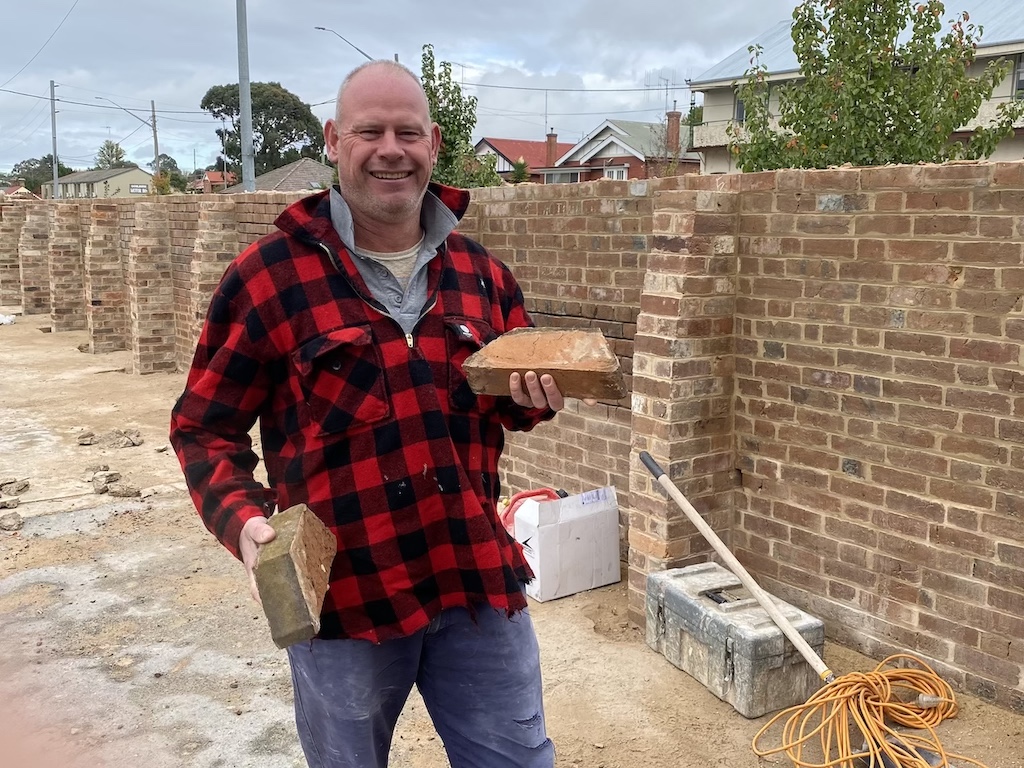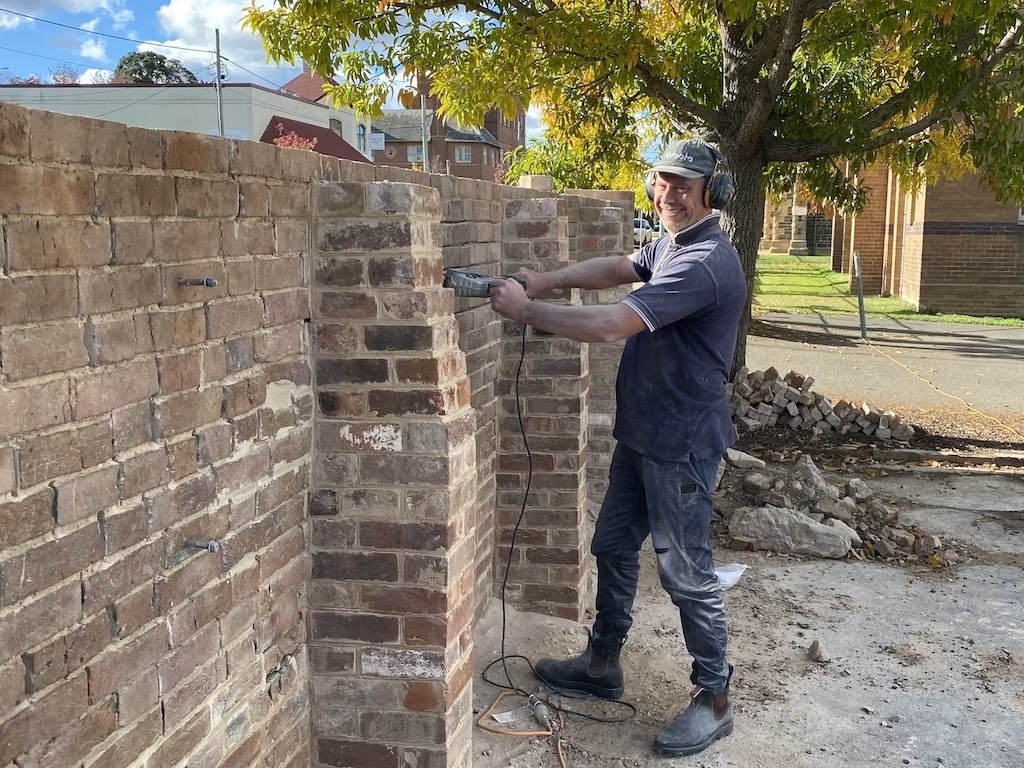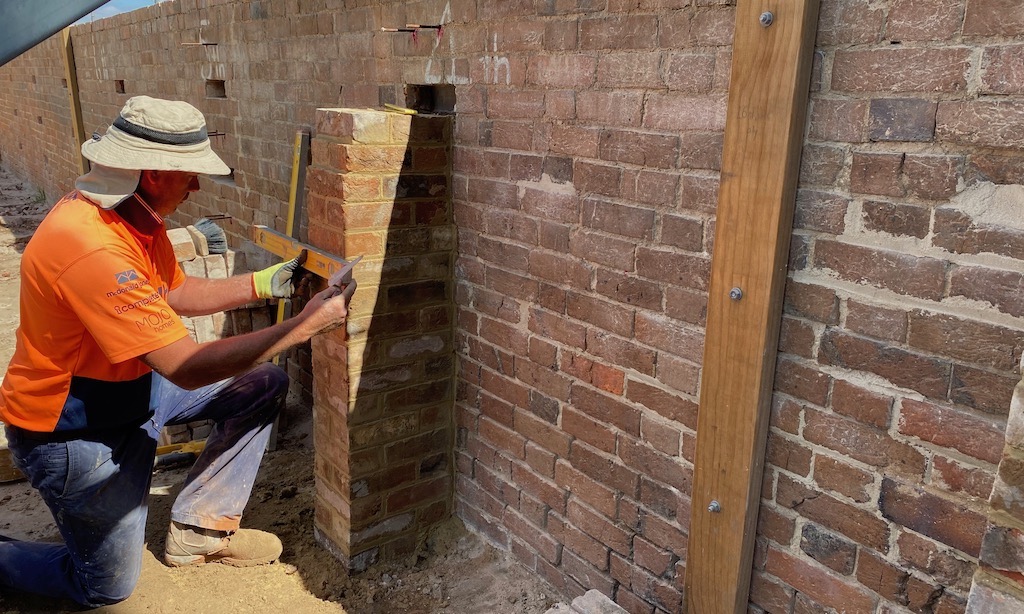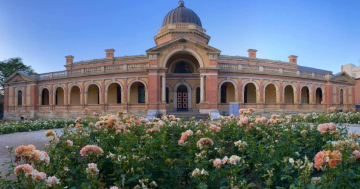
Matthew Chamberlain prepares to add the final sections of a brick wall in Verner Street, Goulburn. He has done much of the repairs voluntarily and enjoys being around buildings created in an era when quality was an imperative. Photo: John Thistleton.
Having studied and sketched in fine-grain detail architecture from ancient to contemporary periods around the world, Steve Ayling paused outside a brick wall being repaired in Goulburn.
Few passersby would take in the minutiae of the work outside of the former St Brigid’s school next to the Old Cathedral in Verner Street.
Impressed with the wall’s “Sussex bond’’ pattern, the buttresses and extra effort evident in the work, the prolific sketch artist introduced himself to Goulburn bricklayer Matthew Chamberlain, who was happy to talk about the repair job.
Fearing the 230-mm (one brick wide) structural pier recommended by engineers to reinforce the wall was inadequate, Matthew has instead built two-and-a-half-brick-wide buttresses. “I thought we would try and keep it within the gothic architecture; I thought I would splay the tops and have them look more like buttresses,” he said.
After seeing the project unfold, Steve questions why new brick homes and buildings are produced with plain stretcher bond, when many distinctive patterns – Flemish bond, monk bond, Scottish bond, header bond to name a few – could add beauty and interest. “Take a lesson from the Federation era,” he says, emphatically.
Matthew says building skills are falling away because successive state governments have abandoned proper technical and further education.
“I’m a great advocate for TAFE and am really disappointed how the (NSW) government has walked away from it, to a degree,” he says.
When he was completing his three-year TAFE course teachers took the apprentices through gothic, period and Victorian styles, and how to do three-centred arches, two-centred arches and segmental arches among other skills. “None of this is taught anymore,” he said. “All these lost arts are going.
“My teacher, Craig Ramstadius, he was top quality,” he said, reflecting on his time at the Wollongong TAFE campus, where three teachers covered all styles of brickwork.
It rankles Matthew to hear the government up in arms about dodgy trades. “It’s becoming a joke because nobody can get any quality trades anymore. Well, look at yourself,” he says, addressing the government.

When they finish their apprenticeship, tradespeople still need several years on the job to become proficient, according to Matthew Chamberlain. Photo: Supplied.
“This is the reason the building industry is going on a downward spiral, because you have completely abandoned the TAFE system,” he said.
When they finish their apprenticeship, tradespeople still need several years on the job to become proficient, according to Matthew Chamberlain. Competency cannot be rushed. Photo: John Thistleton.Workmanship evident in the heritage architecture around Goulburn, including the Old Cathedral precinct, would never be seen again, he said. Coming out of mass one day, he remarked to parish priest Father Joshy Kurien he was available for any brickwork around the place. He wanted to do some voluntary hours for the church, and began fixing the wall that was on a perilous lean.
Over time water had seeped in on one side of the wall where road base bitumen was used. The water could not get out, but on the other side of the wall it was completely dry, making the structure unstable.
Playing down his skills, Matthew said he was not a specialist in colonial brickwork but was passionate about it.
Becoming a brickies labourer in 1999 when he was 17 for one of his schoolmates Joe Harkness’ father Phil, Matt was offered an apprenticeship with the uncompromising, old-school tradesman as they worked on new and older homes in the Southern Highlands.
Matt has always admired the lasting quality of brickwork at the Goulburn Town Hall, now repurposed as the Performing Arts Centre. “A massive effort has gone into that building,” he said of the E.C. Manfred-designed landmark. “It has lasted quite well; the building is still in fantastic condition.”
His appreciation of quality craftsmanship began when he was a youngster tagging along with his mother Therese who worked at the Willow Vale Mill near Crookwell for the owner, Graham Liney.

Checking levels as he goes, Matthew Chamberlain continues repairs on a brick wall in the Old Cathedral precinct. Photo: Supplied.
“He was English himself and had managed to get a hold of these olde worlde skilled guys,” Matt said. “I can member a cabinetmaker, Claud, a Frenchman and the tables he made were just unbelievable. He [Graham] had a lot of stonework in the olde worlde style. He was passionate about buildings.”
Matt jokes that back then his two younger blond-headed twin brothers Michael and James – unlike him – were blessed with good looks and were allowed to serve customers at the mill.
“I was out the back, washing the dishes,” he said, laughing loudly. And yet the work he is turning out these days is a lasting sight to behold.










